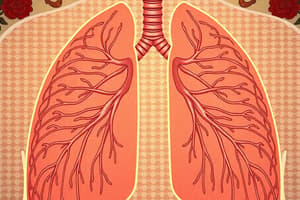Podcast
Questions and Answers
What condition is most commonly associated with a barrel chest?
What condition is most commonly associated with a barrel chest?
- Interstitial Lung Disease
- Pneumonia
- Asthma
- COPD (correct)
Which symptom indicates a potential need for a focused respiratory assessment?
Which symptom indicates a potential need for a focused respiratory assessment?
- Normal breathing rhythm
- Relaxed posture
- Cough with sputum color changes (correct)
- Stable LOC
What anatomical feature increases the risk of aspiration in the right lung?
What anatomical feature increases the risk of aspiration in the right lung?
- Narrow right mainstem bronchus
- Wider right mainstem bronchus (correct)
- Longer left bronchus
- Shorter left bronchus
What is a normal range for pulse oximetry readings?
What is a normal range for pulse oximetry readings?
Which position indicates that a patient may be experiencing respiratory distress?
Which position indicates that a patient may be experiencing respiratory distress?
What is the primary purpose of oxygenation in the body?
What is the primary purpose of oxygenation in the body?
Which of the following would be considered an unexpected finding during a respiratory assessment?
Which of the following would be considered an unexpected finding during a respiratory assessment?
What does the liquid between the pleura in the lungs do?
What does the liquid between the pleura in the lungs do?
What is the primary difference when assessing patients with chronic respiratory conditions compared to those without?
What is the primary difference when assessing patients with chronic respiratory conditions compared to those without?
Which of the following terms best describes the role of oxygenation in the body?
Which of the following terms best describes the role of oxygenation in the body?
Which assessment finding would indicate hypoxia in a patient?
Which assessment finding would indicate hypoxia in a patient?
What abnormal finding may suggest the necessity for further assessment in a patient?
What abnormal finding may suggest the necessity for further assessment in a patient?
What might an unexpected low level of consciousness (LOC) indicate during a respiratory assessment?
What might an unexpected low level of consciousness (LOC) indicate during a respiratory assessment?
During a respiratory assessment, which breathing pattern may indicate tachypnea?
During a respiratory assessment, which breathing pattern may indicate tachypnea?
How does the structure of the right mainstem bronchus impact respiratory assessment decisions?
How does the structure of the right mainstem bronchus impact respiratory assessment decisions?
Which observation may be a sign of respiratory distress during the assessment?
Which observation may be a sign of respiratory distress during the assessment?
What would indicate a successful respiratory assessment?
What would indicate a successful respiratory assessment?
What is the significance of the liquid between the pleura in the respiratory system?
What is the significance of the liquid between the pleura in the respiratory system?
Flashcards are hidden until you start studying
Study Notes
Respiratory Assessment
- Respiratory assessments are important for all patients, especially those with chronic respiratory conditions.
- Assess respiratory function every 8 hours.
- Pay attention to baseline respiratory function to detect subtle changes.
- Key symptoms to consider:
- Chest pain
- Shortness of breath (SOB)
- Dyspnea
- Cough
- Sputum color changes
Oxygenation
- Oxygenation is vital to deliver oxygenated blood to tissues and remove waste.
- It supports intracranial function.
Lung Lobes
- The right mainstem bronchus is wider, straighter, and shorter than the left, making aspiration more likely on the right side.
- Lung airways branch out: bronchi → bronchioles → alveoli
- The lung has a double wall pleura:
- Visceral wall - attached to the outer surface of the lung
- Parietal wall - attached to the thoracic cavity and diaphragm
- The liquid between the pleura minimizes friction during breathing.
Preliminary Findings
- Observe:
- General appearance
- Posture (sitting up or leaning forward)
- Breathing pattern (rhythm, depth, quality, and pattern)
- Sweating
- Noisy breathing (wheezing, stridor)
- Assess Level of Consciousness (LOC):
- Low LOC may indicate agitation or confusion due to hypoxia.
- Inspect:
- Nails, skin, and lips for color
- Skin and fingers for hypoxia, cyanosis, and pallor.
- Expected Findings:
- Relaxed posture, no distress.
- Expected Variations:
- Thoracic breathing is common in females, while abdominal/diaphragmatic breathing is common in males.
- Unexpected Findings:
- Tripod position - Client leans forward with hands on knees, indicating difficulty breathing.
- Abdominal and Intercostal Muscle Use - Ribs pulled in during breathing effort.
- Muscle Retractions - Tugging of the supraclavicular and infraclavicular areas during respiratory distress.
Assessment
- Assess:
- LOC and hypoxia
- Respiratory rate (RR): Eupnea (normal RR), Tachypnea (increased RR), Bradypnea (decreased RR)
- Pulse Oximetry (SpO2): Usually 95-100%
- Unexpected Findings:
- Confusion, agitation, anxiety - Potential signs of hypoxia
- Increased sighing - May indicate hyperventilation
- Hyperventilating - Rapid, deep breathing
Respiratory Assessment
- Assess patients with chronic respiratory conditions and without separately.
- Consider normal baseline for the patient and note deviations.
- Observe general appearance, posture, breathing pattern, and skin for signs of respiratory distress.
- Check for chest pain, shortness of breath, dyspnea, cough, and sputum color changes.
Oxygenation
- Vital for delivering oxygenated blood to tissues and removing metabolic waste.
- Supports intracranial function.
Lung Lobes
- Right mainstem bronchus is wider, straighter, and shorter, increasing aspiration risk on the right side.
- Airways branch from bronchi to bronchioles to alveoli.
- Double wall pleural membrane:
- Visceral wall attached to the lung surface.
- Parietal wall attached to the thoracic cavity and diaphragm.
- Fluid between the pleura reduces friction.
Preliminary Findings: Expected
- Relaxed posture with no distress.
Preliminary Findings: Expected Variations
- Breathing pattern: thoracic - female; abdominal/diaphragmatic - male.
Preliminary Findings: Unexpected
- Tripod position: leaning forward with hands on knees due to breathing difficulty.
- Abdominal & Intercostal Muscle Use: ribs pulled inwards during breathing effort.
- Muscle Retractions: tugging of supraclavicular and infraclavicular regions during respiratory distress.
Assessment: Unexpected
- Altered LOC: confusion, agitation, and anxiety due to hypoxia.
- Increased Sighing: may indicate hyperventilation.
Respiratory Rate (RR)
- Eupnea (normal breathing).
- Tachypnea (rapid breathing).
- Bradypnea (slow breathing).
Pulse Oximetry
- Normal range 95%-100%.
Studying That Suits You
Use AI to generate personalized quizzes and flashcards to suit your learning preferences.




